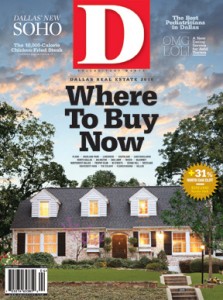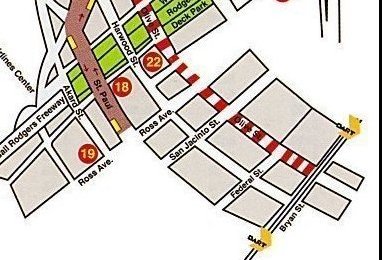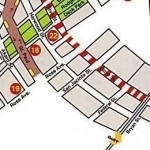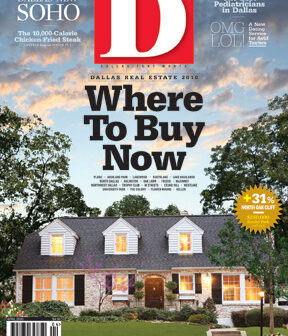If you spend anytime downtown, do yourself a favor and read Peter Simek’s Q&A with Deb Mitchell, one of the principal designers of the park that sits between the Wyly and the Winspear. David Dillon, in the Dallas Morning News, has said the elevation difference between to the two buildings and the stairs it necessitates is a real problem with the park. Mitchell’s response to that? “We found the Wyly was high, but the Winspear was low. We discovered that in 2005, so it’s not like we never saw it, like we’re too dumb and we didn’t see it.”
FrontBurner
Tear down I30 and put it below grade as we did with Central.
1. “Denver’s Revitalized Downtown Gets More Hip By the Minute,” reads this travel piece in the DMN. You see, remaking a downtown isn’t rocket science — Denver pulled it off. Now let’s see, what makes a downtown hip: bike trails, bike rentals, a theme park, kayaking in downtown, and a stadium for a major sports franchise. Hmmm, now let’s look at Dallas. No bike trails, no bike rentals. Kayaking does happen sometimes a mile or so from downtown in the Trinity River. And Dallas has a theme park and stadium. Oh wait, no. Those are in Arlington. (And for those wondering about American Airlines arena, Victory doesn’t count as downtown. If you’ve ever noticed, there’s a highway in between downtown and Victory. Didn’t Ross Perot Jr. see that?)
2. Farmers Branch officials will fight the court ruling that the law the city passed banning the rental of houses or apartments to illegal immigrants is unconstitutional, because Farmers Branch is a town of “law and order,” says Mayor Tim O’Hare.Â
3. Don Hill doesn’t have much to say headed into his 18 year sentence for leading a corruption scheme at Dallas City Hall. How about “sorry I made a mockery of your government, taxpayers.”
You see this little inset from the route map on your website? See how the trolley line up and down St. Paul stops just-this-short of Ross Avenue? Doesn’t look like very much, does it? Maybe 20-30 feet?
Twice in the last month, in approaching that very intersection, I have come across befuddled tourists (tourists! in Dallas!) looking at their maps and trying to figure out where the trolley stop is. So, like the polite citizen that I am, I have stopped, inquired, and assisted.
But what happens when I’m not there? Do they wander off in despair? Do they backtrack their steps and start over again, only to end up in the same befuddled state?
I have an idea. Put a sign at the corner of St. Paul and Ross. Have it say something clever, like
Trolley<—- Here
I think that might help.
Your friend,
Wick
Welcome to Zipf’s Law, which I don’t pretend to understand:
The law claims that the number of people in a city is inversely proportional to the city’s rank among all cities. In other words, the biggest city is about twice the size of the second biggest city, three times the size of the third biggest city…
I leave it to our more statistically minded FrontBurnervians to explain.
Fair Park is commonly referred to as being in South Dallas. It is actually—as the map shows—in East Dallas. In fact, it was once an integral part of East Dallas. When the park’s 277 acres were preserved from development in the 1880s by the concerted efforts of leading citizens such as Alex Sanger, the reason was their proximity to the city’s best neighborhoods. Munger Place and Swiss Avenue are only a few blocks from Fair Park, and Second Avenue, which was the home of the city’s leading Jewish merchants, runs right into it.
How did Fair Park get separated from its original neighborhood moorings?
In 1964, when traffic engineers were even more ignorant about how cities work than they are today, the state completed I-30 by building the present elevated roadway. By that time, blacks had filled in the streets around Fair Park as Jews had moved to newer neighborhoods in North Dallas. In 1964, no black leaders had the political muscle to stop an elevated freeway from segregating their neighborhood from the rest of the city. So the freeway was built, an act of unthinking institutional racism that rammed a barrier through Dallas’ most historic neighborhoods.
The elevated freeway created poverty on both sides of the divide. Mansions on Munger and Second were cut up into apartments and boarding rooms. Only heroic action saved the blocks of Swiss Avenue nearest Lakewood.
I began thinking about the devastating effect of I-30 because of three recent events. The first was a charrette held last year by the construction firm HNTB that envisioned taking the highway down. It had never occurred to me. But then I wrote in our December issue about how Vincent Ponte, the urban consultant, had fought in the 1970s to keep Woodall Rodgers from being elevated as it ran through downtown, arguing that an elevated freeway would forever separate the Arts District from the rest of the city. That and the charrette got me thinking. Then I saw what was happening on Henderson Avenue. Pressure is building to recapture the in-fill neighborhoods that, in the wake of I-30, became a warren of barren lots, shabby apartments, and liquor stores.
As it is, I-30 runs through East Dallas atop an enormous berm. Tearing down that barrier—remember how we fixed Central Expressway in 1999, bringing it below ground—could unleash billions of dollars in property value hidden in Old East Dallas and Fair Park. City leaders have long seen the Trinity River as the divide that separates one part of Dallas from another. Perhaps unconsciously (and once again, one suspects a deep-set, unacknowledged racism), we have been blind to the man-made divide that cuts through the heart of the city, segregating white from black and consigning once-majestic neighborhoods to blight and neglect.
Those neighborhoods—and Fair Park—are too valuable to neglect any longer. The city’s next bond election should include the funds necessary to tear down about 3 miles of I-30, from its interchange with Central Expressway to Samuell Boulevard. HNTB estimated the costs at about $200 million. The benefits are incalculable but real. These neighborhoods now contribute a disproportionately low rate to the city’s tax rolls. By restoring East Dallas as a middle-class community and by stimulating the return of the black middle class to Fair Park, the city will see a huge return on a relatively small investment of $20 million a year for 10 years. The pressure is there. People want to move into the city, close to downtown. All Dallas needs to do is remove the single biggest impediment to its own urban growth.
Write to [email protected].
1. Mark Cuban is planning a huge development — offices, homes, ball fields, an indoor sports facility — in east Oak Cliff. If it comes off, it’ll be a bold move in a part of town that needs it.
2. In today’s Wall Street Journal, our own Willard Spiegelman, who writes the “Good Professor” column for the “print product” each month, has a piece on the artwork at Cowboys Stadium. Willard took a tour of the joint recently and came away quite impressed.
3. Channel 8 last night did the drunk Jerry Jones story in its early broadcasts, which Dale Hansen thought was the wrong decision. So you know what he did? He went “unplugged” on the 10 o’clock newscast and absolutely blasted station management. This is one of the reasons I love the guy. No one else in town has stones that compare to Hansen’s. I sent him an e-mail after the newscast, asking whether station management knew what he was going to say. They did, though they said they’d rather he not do it (and kudos to them for allowing the video to be posted). Hansen also wrote about 30 minutes after they’d signed off: “About 40 emails so far from viewers. Every one saying they agree with me. But then why do TMZ, Inside Edition, Extra and all that other crap do so well??”
Update: Uncle Barky breaks down how the other local stations handled the story last night (or didn’t). Good analysis of Hansen, too.
1. Busy weekend in Oak Cliff — from the art crawl, to the Urban Street Bazaar on Bishop, to Sunday’s party in the parking lot of Kavala, I mean, Crave, bringing bands outside on Davis Street for the first time since that Tejano group rehearsed in that open garage across the street from Taqueria El Si Hay. And lest we forget, for a few fleeting hours, the idiocy that is one-way Tyler St. was transformed into Dallas’ first “complete street.”
2. Dallas City Manager Mary Suhm was in Austin last week to check out her main squeeze, Police Chief Art Acevedo. But Dallas is not the only city courting Acevedo.
3. Will you ever really get tired of watching this?
 Joe Guinto makes the argument that it did in the  cover story in the print edition of FrontBurner this month. His thesis is that missing the boom hurt Dallas real estate prices. He begins his argument by looking at Miami:
Joe Guinto makes the argument that it did in the  cover story in the print edition of FrontBurner this month. His thesis is that missing the boom hurt Dallas real estate prices. He begins his argument by looking at Miami:
During the boom, Miami, overall, saw prices for pre-owned homes appreciate more than 180 percent over where they were in 2000. Dallas, during the peak of the national housing boom–in June 2007–posted about a 26 percent price gain for pre-owned homes over its year 2000 prices. Miami has since sunk. Dallas, too. But Miami’s prices are still 49 percent higher than they were in 2000, whereas Dallas has seen only a 19 percent price appreciation in the same time.
Now, if I were to consider Joe’s argument as a homeowner who wants to sell his house, the facts are incontrovertable. But there’s a whole other side to the story.
I don’t want to sell. I want people to move here and buy. In fact, I want entire companies to move here. Â Let’s say a company is now headquartered in Miami. According to this calculator, the company’s employees would save 49 percent on housing costs alone if it moved to Dallas. Overall, the cost of living in Dallas is 20 percent less than Miami. That’s a fairly huge jump in net compensation — without having to pay a dime more in salary.
I would argue that our low cost of living, along with our lack of an income tax,is  our strongest selling point. We’re 37%  lower than Boston, 21% lower than Chicago, and 45% lower than San Francisco. In the case of San Francisco, also add in the 10% California income tax, and you can double your effective personal income just by moving here. (On top of that, San Francisco is cold, and it snows a lot in Boston and Chicago. But that’s not figured in.)
Jason Roberts Cracks Open Dallas Development Code, Finds Obstacles To Pleasant Street Life

Joel Kotkin Jason Roberts is an effective urban advocate because he works in images: ‘I like cities that look and feel like this, and Dallas doesn’t. Why?’ It’s that “why,” like a four-year old pestering his or her parents to explain the world, that is so effective and annoying to the bureaucratic status quo. Today on Bike Friendly Oak Cliff, Roberts cracks open the Dallas Development Code and finds that many of the street pleasures enjoyed in other cities are either forbidden in Dallas, like fruit stands, or levied with huge fees ($1,000 per awning, canopy, café table, or flower stand). Why?
This is all a lead-up, of course, to Roberts’ urban performance piece this coming weekend, “The Better Block Project,” in which a stretch of Tyler Street will be transformed into the kind of place we would like our city to look like, this time asking, “if only. . .”
1. On his blog, Pete Oppel makes the kind of unsubstantiated, left-field speculative prediction that could just become a self-fulfilling prophesy: Mary Suhm is thinking of retiring. His argument is based on the timing of budget woes, Trinity River Project delays, the hiring of a new police chief, and the recent retiring of the city’s CFO David Cook, who Oppel calls the “Ying to her Yang.” Though Suhm strikes me as the kind of person who likes to leave on highs.
2. Remember when Joel Kotkin was in town? Our friend Patrick Kennedy at Living Car-Free in Big D isn’t too impressed, and he has taking the time slice and dice a piece Kotkin wrote for Forbes about Texas’ future prosperity. What’s Kennedy’s beef with Kotkin? Well, to start, “Kotkin routinely displays all the writerly hypocrisy of unprincipled, think-tank whorishness.” Trust me, it gets better.
3. About that Broad Prize DISD Superintendent Michael Hinojosa said the district would win by 2010, yeah, he meant 2011. So bug him next year.
The folks behind the Woodall Rodgers Park just announced that the Meadows Foundation is writing a $500,000 check to help ensure that the park opens as planned in 2012. (And today CNN runs a story titled “Americans Rebuild for the ‘New Urban Century’,” in which the park is mentioned.) The full release follows after the jump. Zac and I have already made plans to hang out there at lunch, get high, and play Hacky Sack.






